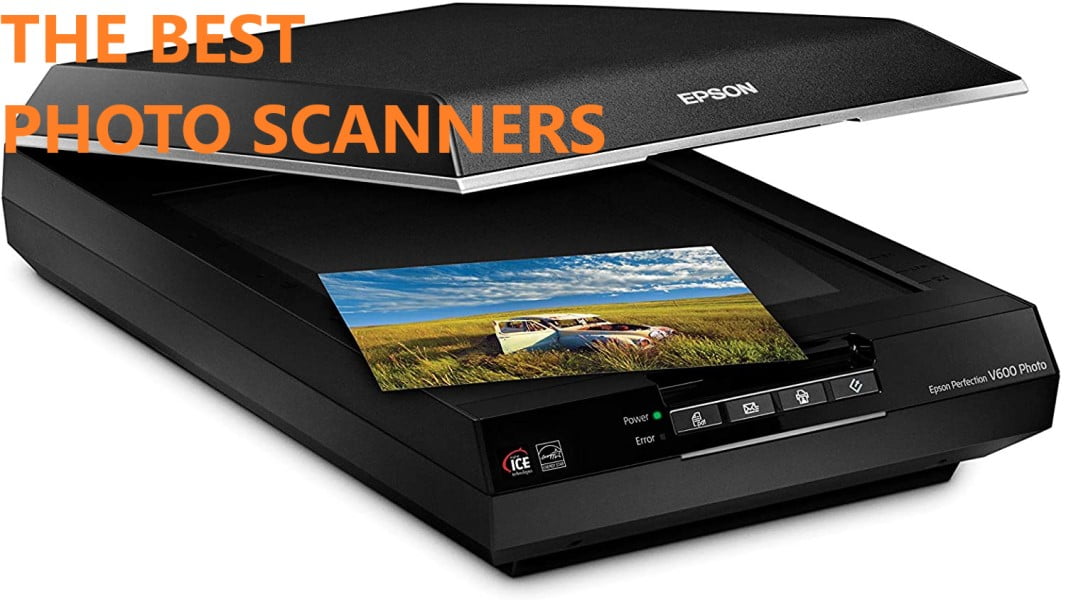Photo scanners are indispensable when it comes to the preservation and restoration of precious memories.
Unlike traditional photo printers, scanners can digitize or resurrect old photos or documents with just the click of a button. There are many photo scanners ranging from flatbeds to automatic feeds, as well as those with the ability to scan from prints or negatives.
We have done more than 30 hours of research and tested 4 models to come up with our review. It includes budget scanners that offer great resolutions, as well as portable photo scanners that you can take anywhere.
At the end of this article, we also dive deep into features and specifications that you should be aware of when picking up a photo scanner.
Here is a summary of our findings. Please scroll below for the individual reviews.
The Best Photo Scanners in 2023
Plustek Photo Scanner EPhoto Z300

Main use: Personal image or document scanning | Scan resolution: Up to 600 DPI| Maximum scan size: 8×10 inches | Feed: Manual | Connection method: USB 2.0
The Plustek Photo Scanner EPhoto Z300 is one of the best photo scanners when it comes to intuitive user experience. It has a minimalist design and produces quick, high-quality images. It can scan up to 8×10 inch photos at up to 600 dpi in just 5 seconds.
The Plustek also includes powerful image enhancement features, which help you alter images and ensure your scans look the best. You can even share your scans via various media including Facebook, Flickr, and Twitter, among others.
Epson FastFoto FF-680W

Main use: Personal image and document scanning | Scan resolution: 300, 600, and 1200 DPI| Maximum scan size: 8×10 inches |Feed: Automatic | Connection method: Wireless or USB
The Epson FastFoto FF-680W is one of the fastest photo scanners on the market today; scanning photos at 300 DPI in just one second per photo.
Images can also be scanned or enlarged to up to 1200 dpi at up to 8.5 inches wide, plus it can scan multiple document sizes in one batch.
It uses Perfect Picture Imaging for auto and manual editing to breathe life back into older images.
This printer also boasts Single-Step Technology to capture both the front and back of any scanned documents; perfect if your precious images have handwritten notes on the back.
The addition of USB or wireless connectivity makes this a great choice among the best photo scanners.
Flip-Pal Mobile Scanner

Main use: Personal image and document scanning | Scan resolution: Up to 600 DPI| Maximum scan size: 4×6 inches | Feed: Manual flatbed | Connection method: SD card
The Flip-Pal Mobile Scanner is a portable scanner that can be taken absolutely anywhere.
It is battery-powered, so there’s no need for tangled wires or to be restricted by where your plug sockets are. Plus you don’t need to attach it to a computer, it’s lightweight and easy to use.
Furthermore, the Flip-Pal can create mesmerizing talking image files by using StoryScans software to combine the user’s voice with the scanned image; bringing the stories behind pictures to life.
You can also stitch multiple scans of larger documents together to create one image. And with a scanning resolution of up to 600 dpi, you can preserve cherished memories without losing any detail.
Epson Perfection V800

Main use: Personal image and document scanning | Scan resolution: Up to 6400 DPI| Maximum scan size: 8×10 inches | Feed: Manual flatbed | Connection method: USB 2.0
The Epson Perfection V800 is a premium document scanner with a staggering resolution of 6400 DPI.
The exclusive Dual Lens System ensures your scanned images are consistently crisp, clear, and vibrant.
LaserSoft Imaging SilverFast SE software automatically adjusts light, color, and sharpness, while Digital ICE technology removes any dust specs without causing damage to precious photos.
A fluid mount tray can be purchased separately which allows wet mount scanning; this fills in any scratches on black and white film and cuts down light refracted on film strips, restoring precious memories.
Kodak Scanza Film and Slide Scanner

Main use: Personal image and document scanning | Scan resolution: Up to 22 megapixels | Maximum scan size: Scans only 35mm, 126, 110, Super 8, and 8mm negatives | Feed: Manual | Connection method: SD card and USB
The Kodak Scanza ensures memories are not forgotten thanks to its perfect preservation of negatives and film slides. A host of adaptors convert 35mm, 126, 110, Super 8, and 8mm negatives and slides into crisp, JPEG digital images, without compromising on quality.
The intuitive user interface provides helpful instructions on a bright 3.5-inch LCD screen. It offers RGB color and resolution editing, plus continuous loading for fast scanning.
Canon CanoScan LiDE220

Main use: Personal image and document scanning | Scan resolution: 4800 DPI| Maximum scan size: 8.5×11.7 inches | Feed: Manual flatbed | Connection method: USB
The Canon CanoScan LiDE220 is a high-performance, budget alternative to high-end scanners.
Its quality surpasses many of its competitors. Its scan resolution is of very high quality at 4800 DPI, plus the Auto Scan function allows for automatic setting adjustment based on the type of document scanned.
Other brilliant features include the ability to expand to scan larger items, plus a Send to Cloud function for quick and easy uploading and sharing.
DoxieGo SE Wi-Fi

Main use: Personal image and document scanning | Scan resolution: 600 DPI| Maximum scan size: 8.5×15 inches | Feed: Manual feed | Connection method: Wi-Fi and USB
Lightweight, compact, and roughly the size of a rolled-up magazine, the DoxieGo is a versatile scanner that combines quality scans with an intuitive user experience.
It uses rechargeable batteries, eliminating the need for cables. It scans up to 600 dpi resolution and comes with mobile apps that allow for easy upload and sharing. Plus it easily uploads the scanned photos to other devices thanks to its built-in Wi-Fi.
Epson Perfection V39

Main use: Personal image and document scanning | Scan resolution: 4800 DPI| Maximum scan size: 8×10 inches | Feed: Manual flatbed | Connection method: USB
The Epson Perfection V39 is a budget, compact scanner that produces high-quality scans. It is user-friendly thanks to its compact design, removable lid, and simple buttons. Furthermore, it has a built-in kickstand for space-saving vertical storage.
The Perfection V39 boasts a 4800 DPI scan resolution, plus Advanced Dust Technology that clears dust specks from documents. It comes with Easy Photo Fix technology which allows you to edit and even restore color to faded images.
Epson Perfection V600

Main use: Personal image and document scanning | Scan resolution: 6400 x 9000 DPI| Maximum scan size: Up to 8×10 inches for documents and 17×22 inches for enlargements. It also scans slides, negatives, and panoramic film up to 6×22 cm | Feed: Manual flatbed | Connection method: USB 2.0
The Epson Perfection V600 scans just about everything you would ever need to scan — negative film, slides, and panoramic film.
The resolution is an impressive 6400×9000 dpi and it can enlarge documents and images up to 17×22 inches. We were pleasantly surprised with the accuracy of its Digital ICE technology, which removes dust particles, scratches, tears, and creases from photos and film.
You can even use the ABBYY FineReader Sprint Plus OCR software to convert documents into editable text PDF files.
Fujitsu ScanSnap iX1500

Main use: Personal image and document scanning | Scan resolution: 600 DPI| Maximum scan size: 8×10 inches | Feed: Automatic | Connection method: Wi-Fi and USB
Last but not least, if you love organizing your scans into folders, the Fujitsu ScanSnap iX1500 will be ideal for you.
It features an intuitive, easy-to-use, 4.3-inch touchscreen. In addition, you have the ability to create user profiles and folders, as well as the ability to add tags and keywords to your digital scans.
It scans up to 600 dpi resolution and uses automatic image cleanup to auto-enhance images. There is also a 50-page Automatic Document Feeder, should you wish to scan large photo albums at once.
How to Choose the Best Photo Scanner
There are a few factors you need to consider before you can make a choice about which photo scanner is best for you.
Important variables you need to consider include:
- What resolution scans do you need? and
- Automatic vs manual feeders.
Your choice will probably depend largely on what you want to scan and why. Let’s take a look at what you should consider.
Consider Scan Resolution
DPI, or dots per inch, is the number of dots or pixels that fit into an inch of a particular document or image file. It is widely known as the resolution.
A higher DPI means a more detailed, higher-quality image. For example, a scanner that scans at 4800 DPI produces images with a better resolution, in comparison to a scanner that only scans at 300 DPI.
If your principal use for scans is to upload to social media or share with family and friends, a dpi of 300 would be more than enough.
However, if you are looking to scan high-detailed sources such as slides or film negatives, or smaller photos for enlargements, a scanner with a DPI of 4800 to 6400 would be more suitable.
Automatic vs Manual Feeders
We have listed a wide range of scanners, both automatic feed and manual feed. But which is best?
Flatbed scanners have a flat, glass surface onto which documents are laid and then scanned from underneath. Each document is individually placed by hand into the scanner. They tend to produce higher quality scans than their counterparts, but the manual process takes longer.
We would recommend you go with a flatbed scanner if you are planning to scan old, fragile photos.
Automatic feeders layer up documents in bulk to scan, similar to a printer’s paper feed. The scanner sorts through them and scans each one automatically. However, from time to time, they are prone to paper jams which may damage photos, especially if they are fragile.
Some of these scanners, such as the Epson Perfection V600 can automatically convert your scanned images to PDF.
Always Back up Your Scanned Images
One thing that you cannot take for granted, is the guarantee your images will always be safe, secure, and protected once they are scanned and digitalized.
Unfortunately, systems and HDDs malfunction, and images can be lost. As a result, it’s imperative you consistently back up your images to an external hard drive or an online photo storage account, preferably both.
Store Originals Safely
Even though scanners help us to preserve or breathe life back into cherished images, the scans should not replace the original photos.
Make sure you always keep the original documents stored in a safe place, just in case digital versions are ever lost.






